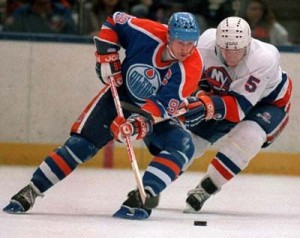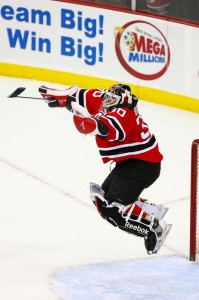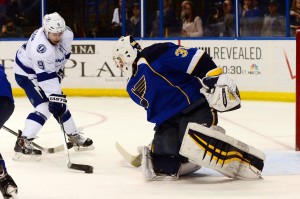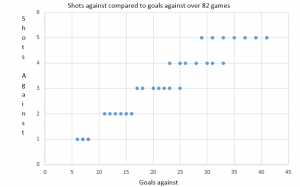For a group of athletes often characterized for clichés and boring interviews, perhaps the greatest player of all time may have actually had a deeper point than he initially intended.

“You miss 100% of the shots you don’t take,” Wayne Gretzky famously uttered, emphasizing the importance of shooting the puck on goal, and perhaps meant to use hockey as metaphor of life to show how a person can never know the result of a situation if they don’t take a risk.
However, Wayne may not have realized how his most well-known quote can be applied to the defensive side of hockey. Rephrased, Gretzky’s quote could also say, “If you don’t let your opponents shoot, they’re bound to not score every time.” While Wayne led teams characterized for having one of the best offences in NHL history, the game has since adapting from 8-6 games that were the norm in the high-scoring days of the 80’s. More and more, defensive play is a factor, and teams that win don’t do so specifically because they drastically outscore their opponents, but rather because they have a low goals against average caused by a combination of strong defensive and goaltending play.
What are goals against?
Okay, that may sound like a stupid question. Everyone who has even the most limited of sports knowledge knows that goals against are goals the other team scores against you. But goals against can also be expressed as the product of a very basic math formula. It’s also just common logic, and a re-working of the formula used to calculate save percentage.
Goals Against= Shots on Goal Against x (1-Save percentage)
If you want to keep it even simpler, you could substitute “opponent’s shooting percentage” instead of 1-save percentage, but that’s not really a widely discussed stat, as it’s just the opposite of save percentage.
Save percentage is a good reflection of goaltender performance, while shots against is a good reflection of the team’s defensive play. It’d be hard to really argue either as anything but. That’s not to say either is a perfect tool to evaluate a goaltender or a team’s defensive efforts completely, but those two stats give a better indicator than any other as to why goals end up in the back of a team’s net.
To minimize goals against, there are mathematically two ways- minimize shots, or get a better goalie.
Since elite goaltenders are not exactly easy to find, let’s analyze the importance of minimizing shots.
Why minimizing shots is crucial
If there was ever a tweet to sum up the importance of minimizing shots, this would be the one.
#Leafs and #Blues goalies have identical .916 save%. Only difference is Blues have allowed 800 fewer shots on goal this season
— David Amber (@DavidAmber) March 25, 2014
Clearly, goaltending isn’t the issue on a team like Toronto (tied for tenth best save percentage in the league), yet massive shot totals have challenged the team all year and remained an issue through a late-season collapse.
For an additional example of how goals against are created, look at Chicago. The team’s goalies sport combined sport a below average .908 save percentage, 21st in the league. However, they give up the 11th least goals in the league, heavily influenced by giving up just 27.1 shots a game (4th best in the NHL).
And lastly, let’s look at the team who gives up the least shots in the league- New Jersey.
Corey Schneider has been good but not great at .915- but the real issue is the NHL’s oldest goaltender in Martin Brodeur, who’s .903 save percentage is well below his personal expectations and career Hall of Fame numbers. Add in that Brodeur has suited up for 36 games, above average for a backup, and that the Devils score just 2.40 goals a game and it’s easy to see why the team is very unlikely to make the post season. Defensive play isn’t an issue in New Jersey, but perhaps a overusing of a goalie past his prime and a disappointing offensive season from almost everyone not named Jaromir Jagr highlight the Devils biggest concerns.

So to give up the lowest possible amount of goals, a team should aim to a) give up a low amount of shots (play better defensively) and b) make a high percentage of saves (have a good goalie).
The following data will illustrate how changing those factors will ultimately influence the goals a team gives up over 82 games.
First off, there is one serious assumption to be made when looking at this data. Assume that the goalies for a team (combined as a unit) will have constant save percentage regardless of the shot totals they face. Examples such as Jonathan Bernier in Toronto or Ryan Miller while in Buffalo show goalies can have great individual statistical seasons while still being barraged with shots, while goalies like Tuukka Rask can thrive while playing under a stacked defensive team.

It is unlikely that a goalie would drastically change his save percentage purely due to shot volume, but rather hover around the same numbers over the course of a season and not fluctuate more than a few percentage points. If a goaltenders’ numbers significantly drop or rise, it’s likely there are more factors than simply shot volume that is to blame.
Either way, it is true that more shots on goal will more often than not lead to more goals. This isn’t meant to be anything groundbreaking or maybe even news to anyone, but rather just a look at how the shots given up over a season can impact a team.
The raw data
I’ve gone ahead and created a “goal difference” chart and graph, which displays how x goals against are created (rounded to the nearest whole) by giving up an average of y more shots per game over an 82 game season under the aforementioned assumptions. Conversely, one could use the same data to see how reducing y shots against would also take away x number of goals if save percentage remains constant over 82 games.
| Fewer shots (y) | Save percentage | Goal Difference (x) |
| 1 | 0.930 | 6 |
| 1 | 0.925 | 6 |
| 1 | 0.920 | 7 |
| 1 | 0.915 | 7 |
| 1 | 0.910 | 7 |
| 1 | 0.905 | 8 |
| 1 | 0.900 | 8 |
| 2 | 0.930 | 11 |
| 2 | 0.925 | 12 |
| 2 | 0.920 | 13 |
| 2 | 0.915 | 14 |
| 2 | 0.910 | 15 |
| 2 | 0.905 | 16 |
| 2 | 0.900 | 16 |
| 3 | 0.930 | 17 |
| 3 | 0.925 | 18 |
| 3 | 0.920 | 20 |
| 3 | 0.915 | 21 |
| 3 | 0.910 | 22 |
| 3 | 0.905 | 23 |
| 3 | 0.900 | 25 |
| 4 | 0.930 | 23 |
| 4 | 0.925 | 25 |
| 4 | 0.920 | 26 |
| 4 | 0.915 | 28 |
| 4 | 0.910 | 30 |
| 4 | 0.905 | 31 |
| 4 | 0.900 | 33 |
| 5 | 0.930 | 29 |
| 5 | 0.925 | 31 |
| 5 | 0.920 | 33 |
| 5 | 0.915 | 35 |
| 5 | 0.910 | 37 |
| 5 | 0.905 | 39 |
| 5 | 0.900 | 41 |

It’s not the most exciting graph, but the results are clearly linear. Each dot moved further to the right represents a 5 percent drop in save percentage, but it can be understood simply by looking at the upward trend.
5-10 goals probably is not a major deal for most teams over the course of an 82 game season, as it’s likely more than a few of these goals would come in situations that were not game deciding. It’s a possibility that these goals could result in changing the outcome of 5-10 one goal games, but it’s more likely a matter of 2 or 3 games, if that. However, for a team on the bubble of the playoffs, those 5-10 goals can be the difference between postseason hockey and an early start on the golf season.
Once you get into any higher totals than that, it’s where those extra shots allowed begin to really become an issue. There isn’t a coach in the league who would be able to say with a straight face that they don’t think 20 or 30 goals can change the course of a season.
Methods to minimize shots:
It’s one thing for a coach to tell his team to give up less shots, it’s an entirely different thing to come up with a plan to execute it. Yet if we analyze the fundamentals of hockey, it’s not tough to see where shots can be minimized. It’s a much easier strategy for a coach to play solid defence and not worry too much about his goalie having an off night now and again, than it is for a coach to expect the best out of his goalie every night and face a shooting gallery.
Block shots
Finding and eliminating shooting lanes, covering the point, and straight up sacrificing one’s body in the right position are the keys to successfully blocking a shot. Blocked shots have increased in popularity over recent years, and are a combination of positioning, guts, and coaching.
Eliminate rebounds:
There’s an old hockey adage something along the lines of “it’s a goalie’s job to make the first save, anything else is on the defence.” While rebound control can be vital to separate a good from an elite goaltender, the defence can also step up to make themselves look better by clearing pucks out of the slot and taking away scoring chances.
Possess and cycle the puck in the offensive zone:
Every second that a team holds the puck in the offensive zone is a second that their opponents must remain defensively conscious, and therefore cannot attempt a shot on goal. On the contrary, breaking up the other team’s cycle will prevent any sustained offensive pressure, which leads to more shots and more scoring chances.
Turnovers:
Turnovers are a funny thing in hockey. In a players’ first few years in the league, they’re often excused as a learning curve. But once players get older, they’re often blamed and blamed again for turning the puck over too often, especially in the defensive zone. Either way, turnovers often lead to high percentage scoring chances. While some turnovers are just the result of strong forechecking by the opposition, often it’s a mental mistake over a physical one that causes a player to lose the puck. While not all turnovers can be avoided completely, there’s usually a better option. A proper mix of rushes, dump-and-chase plays, proper zone breakouts and regrouping when things aren’t working all minimize the chance of giving the puck to the other team, where they have the opportunity to shoot. As well, causing the other team to turn over the puck will, at least temporarily, take away their chance at a shot on goal.
Successful breakouts:
Clearing the puck out of the defensive zone isn’t a hard concept on paper- yet the execution of it can often be poor. While some breakouts can be placed on individual players, if the problem persists, it’s more often than not a coaching failure to correct the issue. A failed breakout can lead to a turnover and more shots on goal, and a tired defensive group is often subject to even more time playing in their own end, which is never a favorable matchup to have.
Discipline:
Taking a penalty at the right time can save a goal (or at least prevent a high-percentage chance), but it’s almost always a better idea to stay out of the sin bin. Putting your team at a disadvantage on the PK, and it’s no surprise shooting percentages go way up on the PK, while save percentages drop.
The traditional view
Again, this isn’t anything groundbreaking. If you play smart hockey, you’re more likely to win. However, it does show how doing all the little things right are crucial to a team’s success. If a team is able to block one more shot a game, manage one less turnover a game, clear out one more rebound a game, take a few less stupid penalties over the course of the season, and have 60 more seconds a night successfully cycling the puck, this data shows how big a difference eliminating five shots a night can be. Even giving up just two or three less shots can be the difference between 10-25 goals. None of those tasks alone seem exceptionally challenging, and completing all of them together can be the make or break of any given game or even the 82 game season as a whole.
It’s pretty likely all of those simple tasks can be improved via good coaching. The right defensive system covering the proper areas of the ice will block more shots and eliminate rebounds, the right breakouts and rushes learned in practice will cause less turnovers, the right structure in the offensive zone will allow a team to cycle the puck better, and a coach that is able to keep his team calm will keep them out of the penalty box. While giving up an average of five less shots less a game might be tough for some teams to manage, it’d be quite the challenging task to argue that there’s no way a team who gives up 30+ shots a night couldn’t eliminate two or three.
In recent years, the culture in hockey has shifted towards the introduction of analysis of the game through tracking shot attempts through the statistics entitled Corsi and Fenwick. While the numbers itself aren’t intended to perfectly represent the quality of a team, they aim to paint a picture of how well a team can possess the puck, and record more scoring attempts than they allow.
If you want to stay “traditional” however, forget Corsi, forget Fenwick, forget any “advanced” stats or analytics, whatever you want to call them. Use them as much or as little as you’d like, but the same analysis can be made at an even more basic level simply looking at minimizing shots on goal. And if that’s too advanced for you, there’s still a lot about hockey that you’ve got to learn.
So there you have it, fixing some basic concepts combined with some basic math, show how eliminating shots is one of the best ways to improve a team.
Wayne was right, though perhaps in more ways than he intended. Every shot counts.
All stats from hockey-reference.com unless otherwise noted.